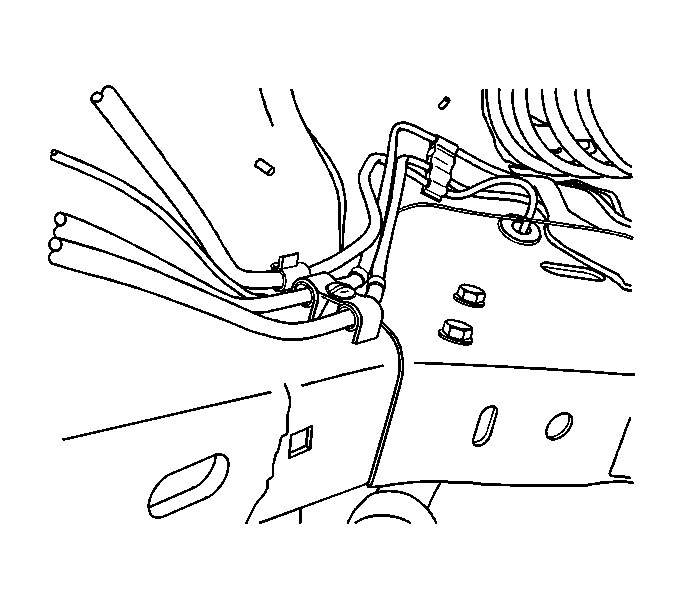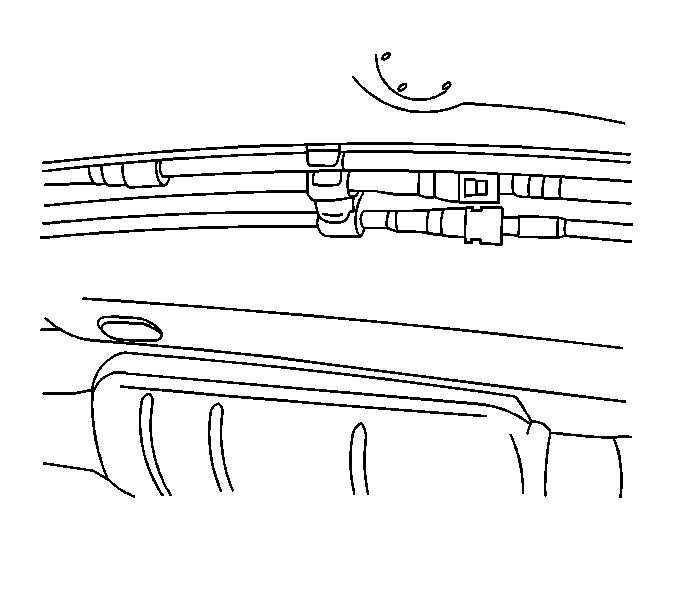Removal Procedure
- Relieve the fuel system pressure. Refer to Fuel Pressure Relief .
- Raise and suitably support the vehicle. Refer to Lifting and Jacking the Vehicle in General Information.
- Remove the plastic shield over the lines in the underbody center section.
- Remove the front fuel supply and return lines from the attaching hardware.
- Disconnect the quick connect fittings to the center section lines, on the right side almost in line with the catalytic converter. Refer to Servicing Quick Connect Fittings .
- Pull the fuel-supply return-lines through the underbody frame support.
- Lower the vehicle.
- Disconnect the fuel lines from the fuel rail.
- Pull the fuel lines through the fender well and out of the engine compartment.
Caution: Gasoline or gasoline vapors are highly flammable. A fire could occur if an ignition source is present. Never drain or store gasoline or diesel fuel in an open container, due to the possibility of fire or explosion. Have a dry chemical (Class B) fire extinguisher nearby.



Installation Procedure
- Remove the protective caps from the replacement lines.
- Install the fuel lines through the fender well from the engine compartment.
- Clean the contamination, if any, from the male line ends and apply a few drops of clean engine oil.
- Reconnect the fuel lines to the fuel rail.
- Raise the vehicle. Refer to Lifting and Jacking the Vehicle in General Information.
- Feed the lines through the underbody frame support.
- Reconnect the quick connect fittings to the center section lines, on the right side almost in line with catalytic converter. Refer to Servicing Quick Connect Fittings .
- Install the fuel supply and return line retaining hardware.
- Lower the vehicle.
- Tighten the fuel filler cap.
- Connect the negative battery cable.
- Crank the engine for a few seconds. Turn OFF the engine if the engine starts.
- Check for any fuel leaks.
- Install the underbody plastic shield over the lines if no leaks are present.
Caution: In order to reduce the risk of fire and personal injury observe the
following items:
• Replace all nylon fuel pipes that are nicked, scratched or damaged
during installation, do not attempt to repair the sections of the nylon fuel
pipes • Do not hammer directly on the fuel harness body clips when installing
new fuel pipes. Damage to the nylon pipes may result in a fuel leak. • Always cover nylon vapor pipes with a wet towel before using a
torch near them. Also, never expose the vehicle to temperatures higher than
115°C (239°F) for more than one hour, or more than 90°C (194°F)
for any extended period. • Apply a few drops of clean engine oil to the male pipe ends before
connecting fuel pipe fittings. This will ensure proper reconnection and prevent
a possible fuel leak. (During normal operation, the O-rings located in the
female connector will swell and may prevent proper reconnection if not lubricated.)

Important: If the lines pass through the metal, be sure that the grommets, if used, are installed and in good condition.
Notice: Use the correct fastener in the correct location. Replacement fasteners must be the correct part number for that application. Fasteners requiring replacement or fasteners requiring the use of thread locking compound or sealant are identified in the service procedure. Do not use paints, lubricants, or corrosion inhibitors on fasteners or fastener joint surfaces unless specified. These coatings affect fastener torque and joint clamping force and may damage the fastener. Use the correct tightening sequence and specifications when installing fasteners in order to avoid damage to parts and systems.
Tighten
Tighten the supply and return lines to 15 N·m (11 lb ft).
Important: Wherever the lines pass through the metal, be sure that the grommets, where used, are installed and in good condition.

